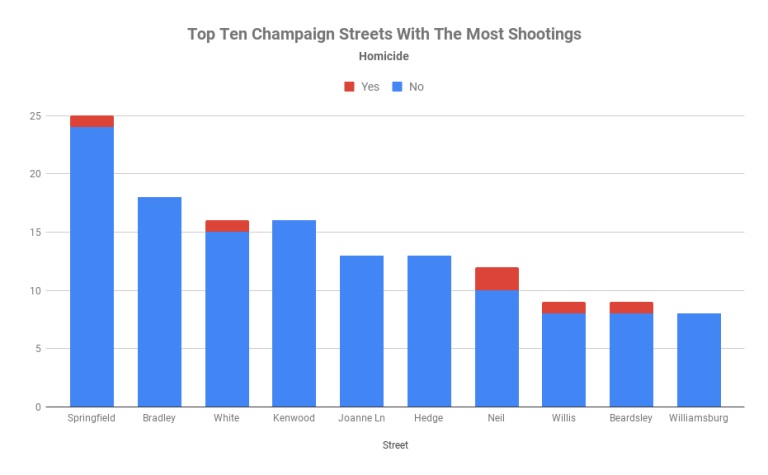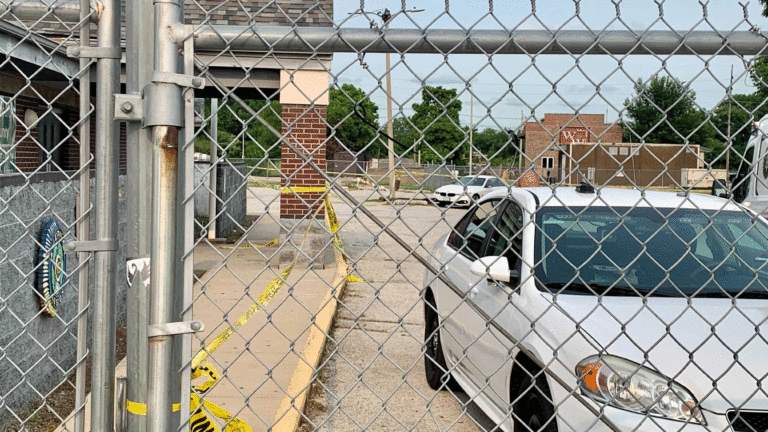CHAMPAIGN — Gun violence in Champaign has steadily marched westward over the past three years as shootings have increased in neighborhoods north and south of West Springfield Avenue, especially in or near several apartment complexes, according to a review of police data over the past seven years by CU-CitizenAccess.org.
Three of the four top blocks with the most shootings in Champaign include an area encompassing parts of Springfield Avenue, White Street and Kenwood Road. Between January 2019 and fall 2021, there were at least 16 people shot and one killed among the 35 shootings reported in that area. In 2018, there were only five shootings in that same area.
CU-CitizenAccess analyzed police data on shooting reports dating back to 2015. This included one self-inflicted gunshot wound because it was during an incident in which another person was wounded and later died. The outlet also filed a public records request for detailed shooting reports between 2019 and the fall of 2021.
The analysis shows that over the past several years, reported shootings in Champaign have pushed into other areas that hadn’t seen gun violence, such as Holiday Park and areas further west and north past Prospect Avenue, such as the 1300 block of Fairfax near Salt and Light Champaign.
From the beginning of 2019 to early October 2021, there have been a total of 494 shooting incidents in the city. Of these shootings:
- 21 have resulted in a death
- 104 have resulted in injuries
- 214 have resulted in only property damage
- 155 have resulted in no injuries
In Champaign, shooting incidents are defined as “any time police find evidence a firearm was discharged, including the discovery of spent shell casings. While it can include damage to life or property, it does not necessarily mean a person was struck,” Champaign Police Spokesperson Tom Yelich said.
Urbana has had 99 shootings this year as of December, a number triple what it was three years ago at 33. Homicides increased from just one in 2019 to nine so far this year. Urbana gun violence is described as being in an “emergency” situation by city officials.
The data from police show that shootings increased in neighborhoods in Champaign that had already been experiencing a high number. Those neighborhoods include Garden Hills and 5th and Hill, for example.
With about two weeks left in this year, 16 people have lost their lives in 2021. Yelich said earlier this year that the violence is “on pace to surpass last year’s number by a wide margin.” Many victims have been young adults ranging in age from 18 to 35 years old, but several teenagers, including three 17-year-old boys, were killed.
In 2020, there were nine homicides, but only two in 2019. Shooting incidents more than doubled in Champaign since 2019, going from 100 shootings, to 189 in 2020, then to 251 by December 13.
Champaign police data on shootings have been maintained inconsistently, but Yelich said police made a major effort to record more details of shooting incidents as “a public service” this past spring. Prior to April 2021, shooting data recorded by police lacked details on whether a person was injured or property was damaged.
“The update was a result of hundreds of staff hours to verify with records,” Yelich said.
However, the updated, detailed data was available only from 2019 through 2021, which added the information on property damage and whether someone was injured.
Deaths lacked geographic links, experts suggest retaliation a key factor
Since 2015, at least 46 people were killed by firearms in Champaign, 26 of which happened within the last three years. 45 of those deaths were homicides and one death was self-inflicted during an incident in which another person was wounded and later died. At least 122 people were wounded in the past three years. Police data on the number wounded from 2015 to 2018 was unavailable.
Champaign County Sheriff Dustin Heuerman said the rise in shooting incidents can be partly attributed to retaliation in a lot of cases.
“The thing we’re seeing is that it’s not just one instance that happens, there’s a lot of retaliation that happens back and forth,” Heuerman said. “Which just really keeps the cycle going.”
An analysis by CU-CitizenAccess.org shows since 2015 large clusters of shootings in the neighborhoods of Garden Hills, 5th and Hill, Beardsley Park and MLK Subdivision.
Smaller clusters occurred in other areas such as Holiday Park and Ridgewood.
Others happened near apartment complexes, including Country Brook and Champaign Park, which are next to each other, and near Mattis North in the Garden Hills neighborhood, Oakwood Trace near the MLK Subdivision and Town Center near the Marketplace Mall.
One block areas had two fatalities: 300 to 400 E. Hill in the 5th and Hill neighborhood. But there were two homicides on Neil at 2400 N. Neil St. near a few apartments, including Town Center, and the 1500 block near I-74.

Overall, the data shows five streets with the highest number of shooting incidents from 2019 to 2021:
- Springfield Ave in west Champaign, mainly the 2000 to 2700 block, had 25 shootings and one death
- Bradley Ave, from the 300 block near N. Neil St to the 2000 block near Parkland, had 18 shootings, but no deaths
- White St, mostly the 2100 block near Champaign Park, had 16 shootings and one death at the 300 block close to downtown
- Kenwood Rd, from the 100 to 800 block in the Holiday Park and Champaign Park Apartments area, had 16 shootings, but no deaths
- Hedge Rd in Garden Hills, along the entire road, has 13 shootings and no deaths, similar to Joanne Ln in the same neighborhood
Illinois ahead of nation’s pace for increasing gun violence
Nationally, gun violence has risen over the course of the last year, spiking near the start of the COVID-19 pandemic, and data from the Centers for Disease Control and Prevention shows the death rate from firearm-related injuries in Illinois has risen from around 9 deaths in 2015 to around 11 deaths per 100,000 people in 2019. The death rate increased nationally from 11.3 to 12.1 deaths per 100,000 in the same time period, meaning Illinois’s firearm deaths were increasing at a rate faster than the nation as a whole.
Illinois has a population of around 12.6 million, and 1,367 people died in 2019, the latest year for CDC WONDER data, compared with around 1,250 in 2015. The data also shows Champaign County has seen around 15 deaths by firearms per year since 2015, too low to produce a reliable rate given its population. Nearby counties have rates assigned, such as Macon County with 20.2 deaths per 100,000, or Peoria County with 15.1, but these counties have lower populations.
Local community leaders said the underlying causes of gun violence have been brewing for years, long before COVID-19 entered the community.
“There has been an uptick here, coming out of COVID, but those have been issues in this community for a long time,” said Marlon Mitchell, founder of First Followers, a community-based organization operating in Champaign-Urbana. He said the organization usually focuses on reentry programs for formerly incarcerated, but has recently begun state-funded work to combat gun violence.
Champaign Community Relations Manager Tracy Parsons said how city leaders are collaborating with residents to try to come up with solutions to reduce shooting incidents using local resources.
“We’re trying everything we can, we’re meeting with community groups, neighborhood groups, to try to get feedback on what they believe some of the remedies and solutions are,” Parsons said. “So there’s nothing that is not what we’re not looking at. We’re looking at everything that we can and every approach that we can take to stop and eliminate our gun violence crisis.”
D.J. Roach, Salem Isaf, Claire O’Brien, Ryan Head and Luis Velazquez contributed to this story.

